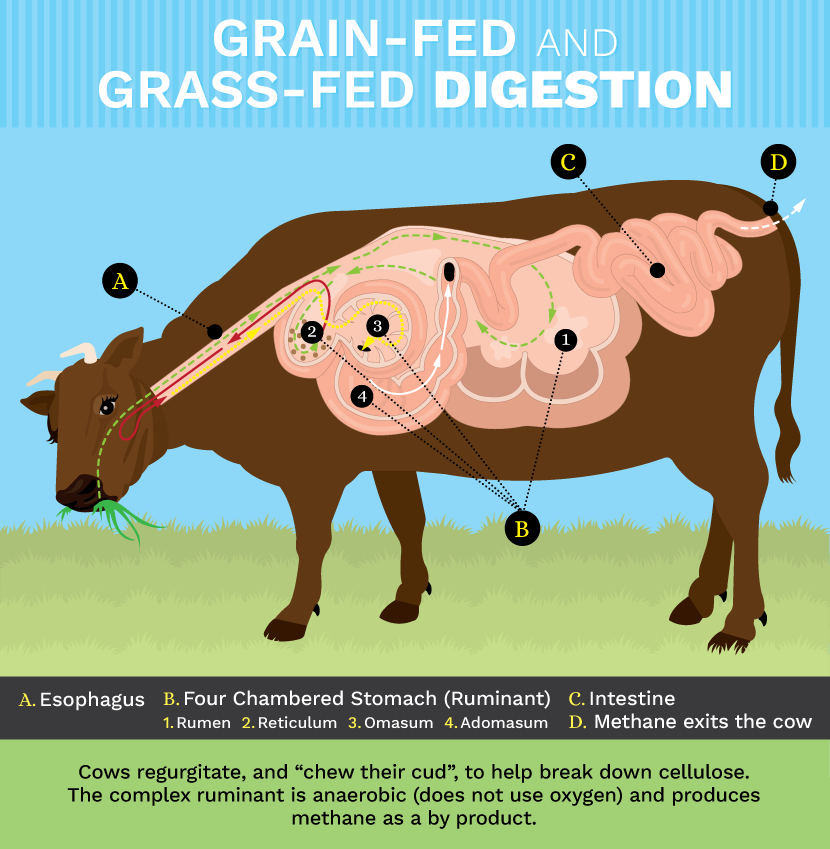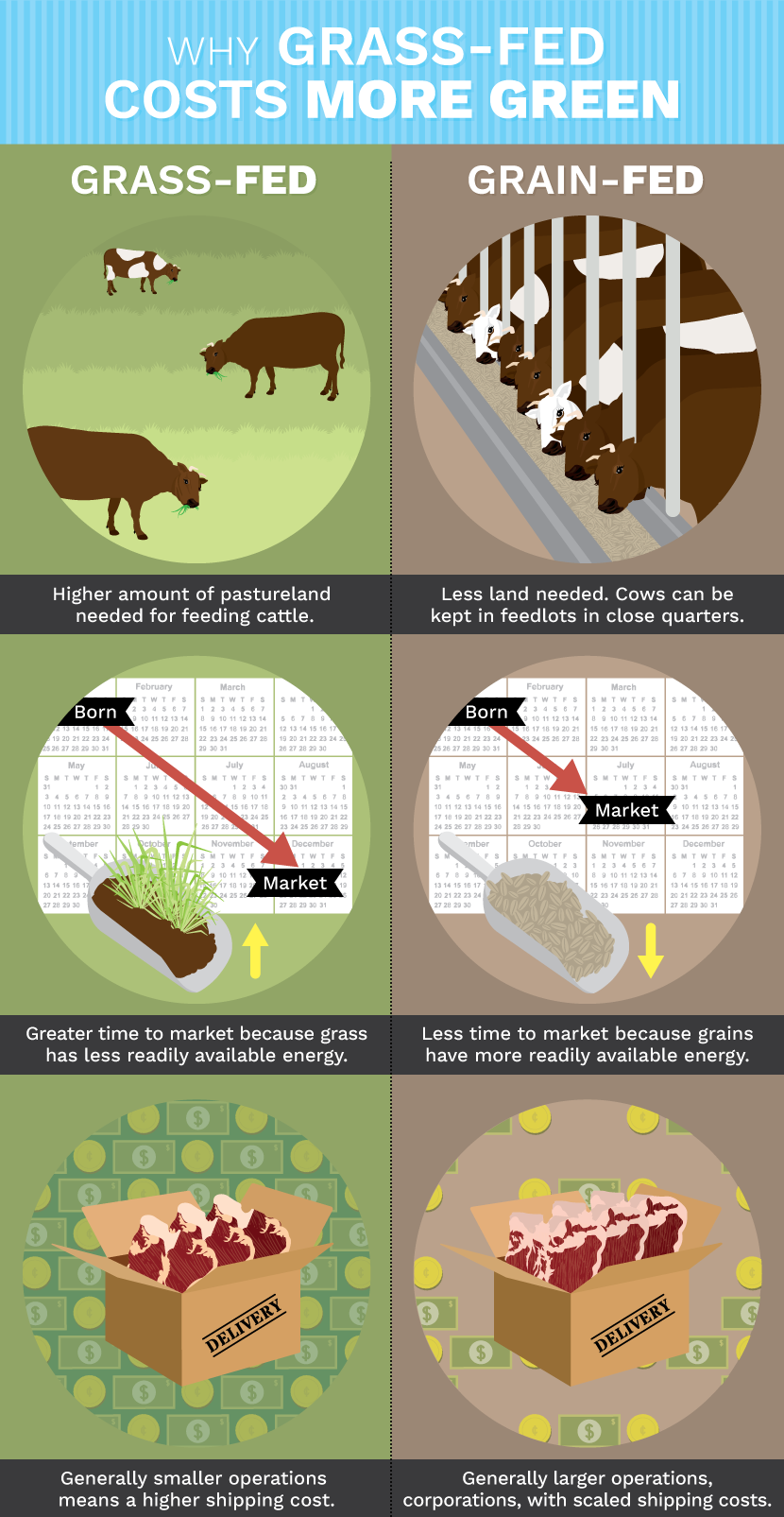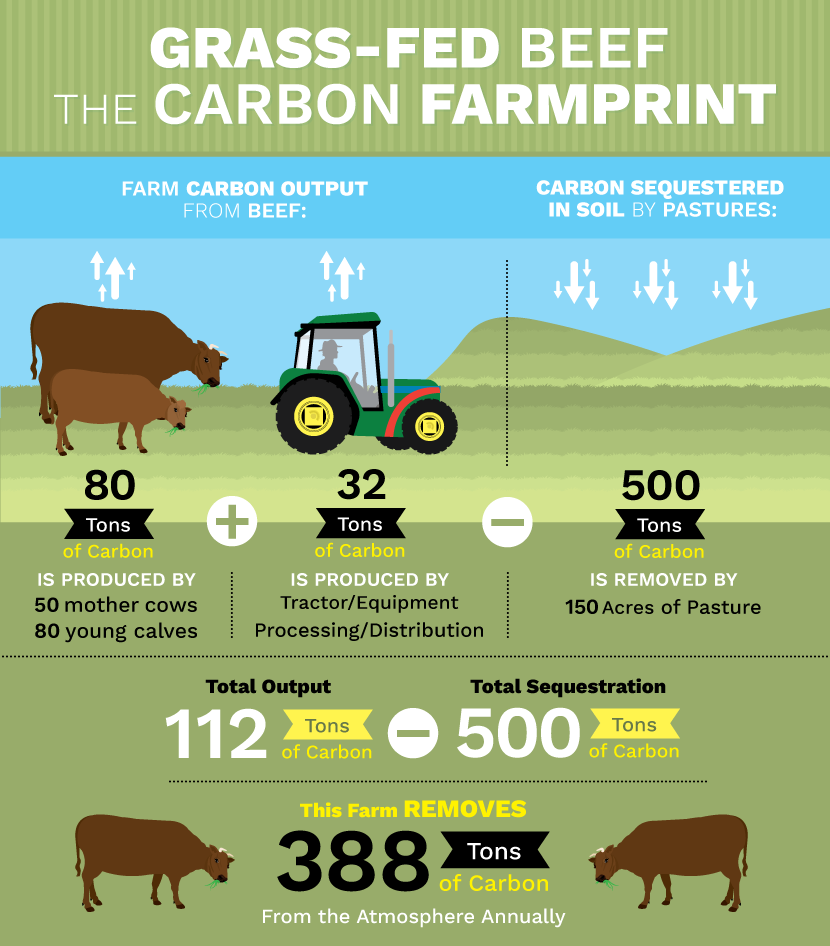Any trip through the countryside is not complete without admiring cows mooing about in fields of green, grazing on what’s beneath their noses. You’ve probably even eaten grass-fed beef before without realizing it. So what’s the big deal? Is “grass-fed” just another label used to trick you into spending more on the same product?
Nope. The majority of beef on the plates of North Americans does not come from grass-fed cows as you might expect. It comes from grain-fed cattle raised in a less than natural setting. So “grass-fed” really tells you something about the way the cattle were raised – both their diet and their living conditions.
To find out whether grass or grain is for you, consider some of the differences and similarities between the two, from nutrition to price to environmental cost.
A Cow’s Life
Cows are herbivores, born to graze on grasses, clover, and whatever other delicious treats sprout from fertile fields. But grasses are neither rich in nutrients nor easy to digest. This is where the cow’s famous four stomachs and chewing the cud come into play. The physical breakdown of grasses by the teeth, followed by the bacterial breakdown in the rumen, eventually makes the nutrients available for absorption later down the line.
While it seems unnatural for cows to eat grains like corn – especially processed grains – based on their biology, it doesn’t mean that they can’t grow on a corn-based diet. Bacteria in the rumen are diverse and some are suited to breaking down grains, others to breaking down grasses. The more a cow feeds on one type of food, the more the bacteria that break it down will flourish. But there is an interesting side effect of a grain-based diet. Because grains are much, much easier to break down than grass and have a lot more readily available sugars, cows stop chewing their cud – one pass through the rumen is enough. This speeds up the overall digestion process considerably.
Cows Are (Mostly) What They Eat
Protein is protein, but fat comes in many forms of varying desirability both in type, flavor, and distribution in the body. Diet and rearing both play a role in these factors with Japanese wagyu beef and grass-fed on opposite sides of the spectrum. Wagyu cattle are genetically predisposed to extensive marbling, but they are also fed grains and alcohol (beer or sake usually), and are massaged to keep their muscles tender. One thing they’re not doing is frolicking in any fields. Grass-fed cattle on the other end are frolicking for the better part of their lives and as a result tend to have less fat marbling in the meat, but more beneath the skin. Which is better? Subjectively, it’s a matter of taste depending on the flavor and marbling of the cut. Objectively, it’s a matter of food quality and animal health and happiness.
Isn’t Grass Free?
Grass-fed beef is almost always more expensive than conventional beef, but shouldn’t it be cheaper? After all, grass is basically free.
Well, grass may be free, but land is not, and it takes a lot more land to raise the same number of cattle on pasture than in a feedlot. And that land has to be of good quality to sustain a herd of grazing cattle. Due to the faster growth of grain-fed cattle, farmers can get them to market much sooner. That higher turnover means more cash flow, better margins, and lower prices for consumers of grain-fed beef. Ultimately, the difference in price comes down to scale. Grass-fed beef is really only realistic on a small scale, and smaller scale will always mean higher planning, production, and maintenance costs for the farmer, which have to be passed on to the consumer to keep the enterprise afloat.
Grass-fed Beef and the Planet
Cows have long since been climate change scapegoats, accused of farting and burping our atmosphere into a crisis, but grass-fed beef might just change that image. The difference isn’t in what they eat but how and where they graze. Cows in feedlots have their poop cleaned up for them and subsequently spread onto fields to inject some nutrients back into the soil. But this is not really the most efficient way to do things.
Grass-fed cattle poop on the fields that their food came from. So the organic matter gets returned right back to where it came from, building the soil up along the way as other cattle or farmyard chickens spread it all around. So while some carbon is indeed lost to the atmosphere, more is sequestered in the ground. Soil is the lifeblood of any farm, and the higher the organic matter content in the soil, the healthier and more stable it will be. It’s a natural, effective, and sustainable cycle that can actually improve the overall health of the land.
The Middle Ground
It’s easy to sit at the dinner table over a T-bone and debate the economic, environmental, ethical, and gastronomic merits of feeding cows grass versus grain, but the reality is that pure and true grass-fed beef can be difficult to come by, especially in colder climates. Where is the footloose and fancy-free cow supposed to get its fresh grass when the ground is frozen and covered in three feet of snow? Should we ship them all to finer pastures? To remain economically viable, farmers will often substitute hay and grains for fresh grass until the spring grass returns. Some farmers even opt to feed their cattle grains for the bulk of their lives and give them a grass treat at the end — grass-finished beef.
 Is Grass-Fed Beef Really Better For The Planet? Here's The Science
Is Grass-Fed Beef Really Better For The Planet? Here's The Science
What’s a Consumer to Do?
Go local and grass-fed if possible, but be flexible.
Grass-fed beef is more of a throwback to small-scale farming than a fad, but grass-fed cattle farmers do need our support so grass-fed beef doesn’t fade completely away. Buy direct from farmers and talk to them about their successes and problems. Find out where the cost difference goes; chances are it’s right back into the farm to make the best product they can for you year after year whether the cows are grass--fed or grain-fed.
If grassy lands are scarce or expensive to maintain where you live and you still want beef, you’ll need to decide whether supporting local farmers trumps shipping in grass-fed. Remember that protein is protein, so if you’re into it for the health benefits, get your fattier cuts from grass-fed cows and leaner cuts from grain-fed cows. Likewise, if the cost of grass-fed filet mignon is prohibitive, venture into the cheaper and more adventurous cuts when going grass-fed. Tongue, liver, heart, bones, tallow, and marrow will all reap you great health benefits at a much lesser cost.






















